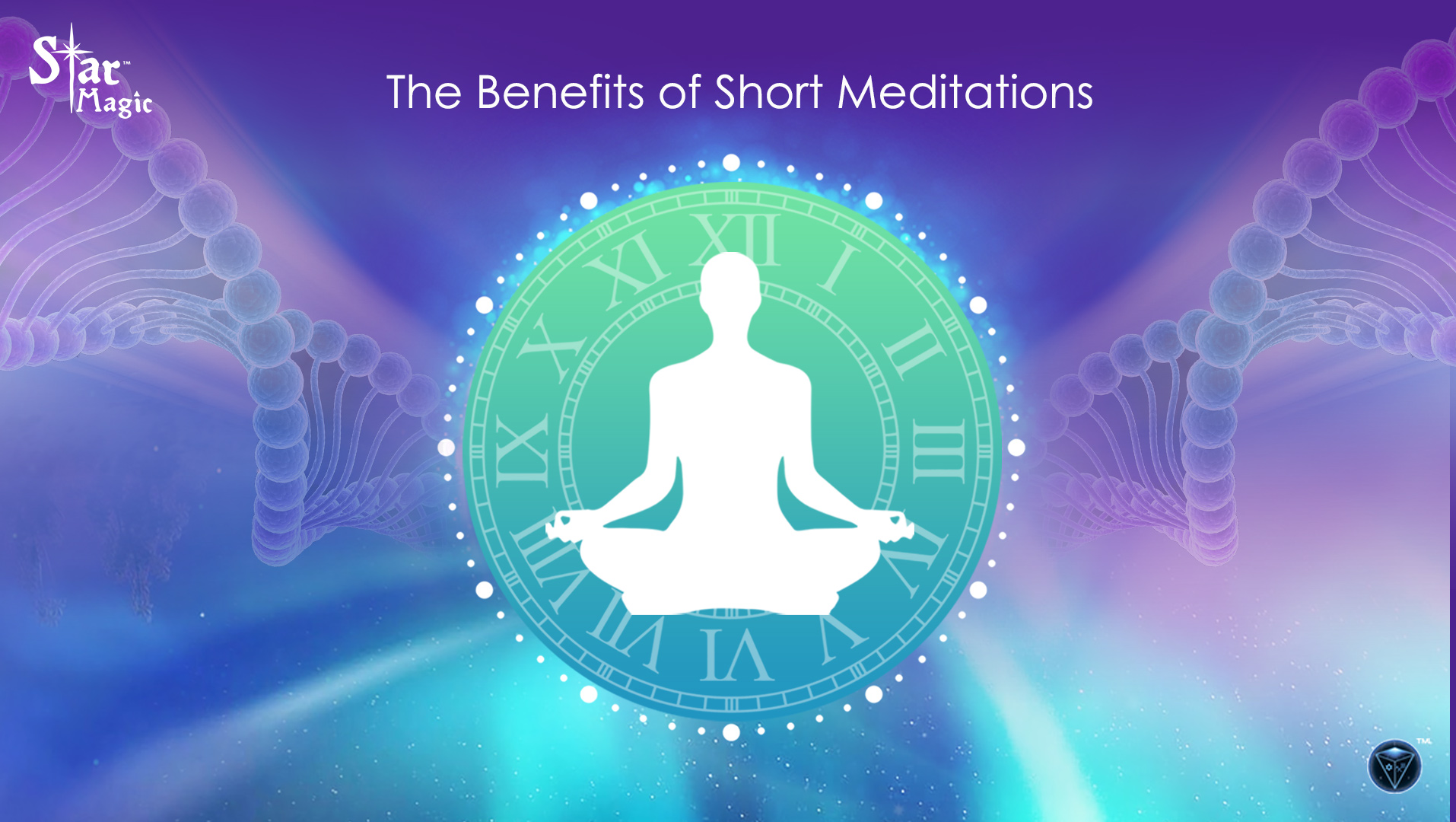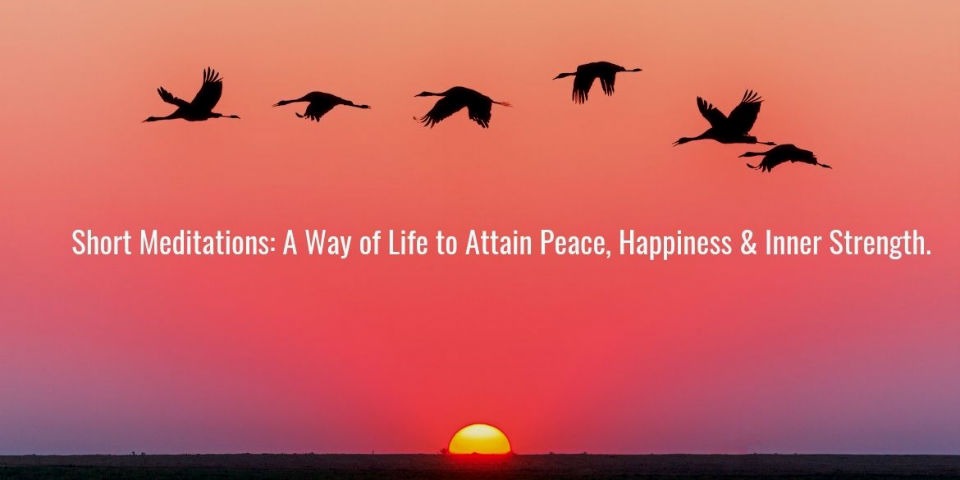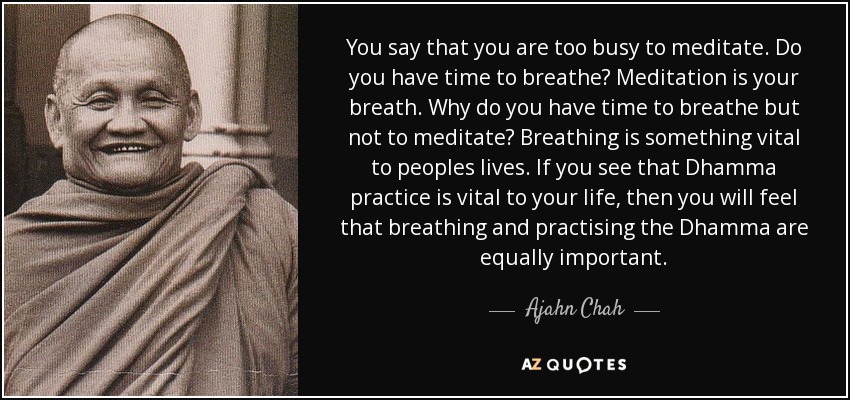The Benefits of Short Meditations

Human beings have practised meditation as part of a healthy lifestyle for millennia. Meditation increases awareness of your surroundings, and of your body, breath, and mind.
You meditate to train your mind to focus and redirect your thoughts. Meditation relaxes your mind, reduces stress, and facilitates the development of concentration and mindfulness.
You may have been put off from the idea of meditation just because you feel that you don’t have the time. The great news is that even a few minutes of daily meditation will benefit you.

There are many benefits of short meditations. A few minutes each day will help you to develop a positive mood and outlook, increase your self-discipline and promote healthy sleep patterns.
Scientific studies have shown that meditation, whether short or long, can promote significant changes within you. Brain scans and neuroimaging have shown that meditation causes changes in the brain that are related to enhanced concentration.
Some Benefits of Short Meditations
Short meditations are normally 15 minutes or less. You are unique and what you consider short may be very long to another.
A short meditation after you wake up in the morning will recharge you for your day. One in the evening will help you unwind at the end of a busy stressful day at work.

Short meditations are ideal if you are on a busy schedule or if you become restless after a few minutes. Long meditations are great to do if you have the time and motivation for them.
Short mindfulness meditations can encourage you to reflect on the moment. This also helps you to step back from your life and make more rational decisions. Meditation allows you to take time out of your day and focus on the information available in the present moment.
Short meditations lower the amount of time you may focus on past memories or future worries. This psychological shift leads to less negative emotions and a happier outlook on life.
You Are Less Distracted
You are less likely to be distracted if you meditate for a shorter time. Short meditations are great for beginners as well as busy people. Staying still for long periods of focussing on one thing for a long time can be difficult if you are not used to this.
Meditation allows you to let go of your thoughts. During meditation, you learn to bring your attention back to the present moment. Distractions are going to come and you accept them so you can let go of them.
Short meditations are very useful if you are easily distracted. A shorter meditation may be just the ticket. A few minutes twice a day in meditation is great if you have trouble with focusing, experience physical pain, or struggle to sit down for a long period of time.

Short Meditations Are Easy to Schedule
You may feel that your life is too busy for meditation. Finding 30 minutes or more to dedicate to meditation can feel impossible if you struggle to find a minute to go to the bathroom.
Two or three minutes of time out of a busy day to meditate will benefit you. The beauty is that you can do a few minutes meditation whilst walking, on the bus or train, or during your break to recharge. During meditation, you take the pressure off your day and open up a new world of possibility.
A few minutes a day every day will get you into doing it every day perhaps at several times each day. This will open the door to wanting to do more. Then you try one or two long meditations a week.
You are more likely to get interrupted the longer your meditation is. Finding a quiet space for meditation when you are responsible for children or share a space with others can be very challenging. You may still find the time for a short meditation and you can also sneak off to the bathroom for 2 or 3 minutes if that is the only quiet time you can get.

You will Remember and Focus More
In long guided meditations there are often a lot of long silences. During those lengthy silences, you might forget what the meditation was about if you get distracted too much. You may drop off to sleep or start to wonder if the meditation has ended or not.
You are less likely to get distracted with a shorter meditation. Then you are less likely to forget what the meditation was about. Also, you are more focussed on the meditation itself knowing it will end in a few minutes.
You are training your brain like a muscle when you focus on your breath in a relaxed manner. You learn to regulate your emotions by raising your awareness of mental processes as they are happening.

You are less likely to Fall Asleep
You are more likely to drop off to sleep if you meditate straight after you wake up or just before bed. You may also drop off to sleep if you close your eyes because you are tired. Closing your eyes and sitting still for a longer meditation increases the chances that you’ll fall asleep.
Sleep is good for you and if you fell asleep while meditating then maybe it is the sleep you need. Falling asleep halfway through meditation means you get some but not all of the benefits of meditation. A shorter meditation builds confidence in your meditation ability while reducing the chances of you falling asleep.
Meditation is a perfect substitute for power naps. If you like to nap for a few minutes to catch up on sleep then why not try meditation instead. A few minutes focussing on your breath, with love at your heart or the clarity of your mind, can recharge your batteries and boost your cognition.
You Feel Free to Meditate More

When you meditate for shorter periods of time it opens the door for you to practice multiple times a day when you have more time. This is very useful if you meditate to reduce anxiety or stress because it allows you to practice whenever you need it.
Create a portfolio of short meditations that you can easily remember and do anywhere you can. Find a meditation short enough to suit however much time you have when you feel the need.
Commit your favourite meditations to memory, use an app, or do what comes naturally. Then you will access the calm and peaceful state that comes with meditation anytime, anywhere.
Short or long, meditation has the power to change your mood, your day, and even your life. Try a short meditation today – simply click here to go to the meditation library and pick the Short Meditations category. Your doors of perception will open and you will be amazed by what you experience.
Healing For Horses Enquiry Form
"*" indicates required fields
Sign up for our weekly newsletter, for inspiration and fresh content from Jerry Sargeant.
Event Enquiry Form
"*" indicates required fields
Sign up for our weekly newsletter, for inspiration and fresh content from Jerry Sargeant.
[mc4wp_form id=”168″]
Download Prospectus Form
[contact-form-7 id=”50219″ title=”Download Propesctus Form”]
Download Prospectus Form
[contact-form-7 id=”50219″ title=”Download Propesctus Form”]
Star Magic
Accessibility Statement
- sminfozzle.testingweblink.com
- December 14, 2025
Compliance status
We firmly believe that the internet should be available and accessible to anyone, and are committed to providing a website that is accessible to the widest possible audience, regardless of circumstance and ability.
To fulfill this, we aim to adhere as strictly as possible to the World Wide Web Consortium’s (W3C) Web Content Accessibility Guidelines 2.1 (WCAG 2.1) at the AA level. These guidelines explain how to make web content accessible to people with a wide array of disabilities. Complying with those guidelines helps us ensure that the website is accessible to all people: blind people, people with motor impairments, visual impairment, cognitive disabilities, and more.
This website utilizes various technologies that are meant to make it as accessible as possible at all times. We utilize an accessibility interface that allows persons with specific disabilities to adjust the website’s UI (user interface) and design it to their personal needs.
Additionally, the website utilizes an AI-based application that runs in the background and optimizes its accessibility level constantly. This application remediates the website’s HTML, adapts Its functionality and behavior for screen-readers used by the blind users, and for keyboard functions used by individuals with motor impairments.
If you’ve found a malfunction or have ideas for improvement, we’ll be happy to hear from you. You can reach out to the website’s operators by using the following email
Screen-reader and keyboard navigation
Our website implements the ARIA attributes (Accessible Rich Internet Applications) technique, alongside various different behavioral changes, to ensure blind users visiting with screen-readers are able to read, comprehend, and enjoy the website’s functions. As soon as a user with a screen-reader enters your site, they immediately receive a prompt to enter the Screen-Reader Profile so they can browse and operate your site effectively. Here’s how our website covers some of the most important screen-reader requirements, alongside console screenshots of code examples:
-
Screen-reader optimization: we run a background process that learns the website’s components from top to bottom, to ensure ongoing compliance even when updating the website. In this process, we provide screen-readers with meaningful data using the ARIA set of attributes. For example, we provide accurate form labels; descriptions for actionable icons (social media icons, search icons, cart icons, etc.); validation guidance for form inputs; element roles such as buttons, menus, modal dialogues (popups), and others. Additionally, the background process scans all the website’s images and provides an accurate and meaningful image-object-recognition-based description as an ALT (alternate text) tag for images that are not described. It will also extract texts that are embedded within the image, using an OCR (optical character recognition) technology. To turn on screen-reader adjustments at any time, users need only to press the Alt+1 keyboard combination. Screen-reader users also get automatic announcements to turn the Screen-reader mode on as soon as they enter the website.
These adjustments are compatible with all popular screen readers, including JAWS and NVDA.
-
Keyboard navigation optimization: The background process also adjusts the website’s HTML, and adds various behaviors using JavaScript code to make the website operable by the keyboard. This includes the ability to navigate the website using the Tab and Shift+Tab keys, operate dropdowns with the arrow keys, close them with Esc, trigger buttons and links using the Enter key, navigate between radio and checkbox elements using the arrow keys, and fill them in with the Spacebar or Enter key.Additionally, keyboard users will find quick-navigation and content-skip menus, available at any time by clicking Alt+1, or as the first elements of the site while navigating with the keyboard. The background process also handles triggered popups by moving the keyboard focus towards them as soon as they appear, and not allow the focus drift outside it.
Users can also use shortcuts such as “M” (menus), “H” (headings), “F” (forms), “B” (buttons), and “G” (graphics) to jump to specific elements.
Disability profiles supported in our website
- Epilepsy Safe Mode: this profile enables people with epilepsy to use the website safely by eliminating the risk of seizures that result from flashing or blinking animations and risky color combinations.
- Visually Impaired Mode: this mode adjusts the website for the convenience of users with visual impairments such as Degrading Eyesight, Tunnel Vision, Cataract, Glaucoma, and others.
- Cognitive Disability Mode: this mode provides different assistive options to help users with cognitive impairments such as Dyslexia, Autism, CVA, and others, to focus on the essential elements of the website more easily.
- ADHD Friendly Mode: this mode helps users with ADHD and Neurodevelopmental disorders to read, browse, and focus on the main website elements more easily while significantly reducing distractions.
- Blindness Mode: this mode configures the website to be compatible with screen-readers such as JAWS, NVDA, VoiceOver, and TalkBack. A screen-reader is software for blind users that is installed on a computer and smartphone, and websites must be compatible with it.
- Keyboard Navigation Profile (Motor-Impaired): this profile enables motor-impaired persons to operate the website using the keyboard Tab, Shift+Tab, and the Enter keys. Users can also use shortcuts such as “M” (menus), “H” (headings), “F” (forms), “B” (buttons), and “G” (graphics) to jump to specific elements.
Additional UI, design, and readability adjustments
- Font adjustments – users, can increase and decrease its size, change its family (type), adjust the spacing, alignment, line height, and more.
- Color adjustments – users can select various color contrast profiles such as light, dark, inverted, and monochrome. Additionally, users can swap color schemes of titles, texts, and backgrounds, with over seven different coloring options.
- Animations – person with epilepsy can stop all running animations with the click of a button. Animations controlled by the interface include videos, GIFs, and CSS flashing transitions.
- Content highlighting – users can choose to emphasize important elements such as links and titles. They can also choose to highlight focused or hovered elements only.
- Audio muting – users with hearing devices may experience headaches or other issues due to automatic audio playing. This option lets users mute the entire website instantly.
- Cognitive disorders – we utilize a search engine that is linked to Wikipedia and Wiktionary, allowing people with cognitive disorders to decipher meanings of phrases, initials, slang, and others.
- Additional functions – we provide users the option to change cursor color and size, use a printing mode, enable a virtual keyboard, and many other functions.
Browser and assistive technology compatibility
We aim to support the widest array of browsers and assistive technologies as possible, so our users can choose the best fitting tools for them, with as few limitations as possible. Therefore, we have worked very hard to be able to support all major systems that comprise over 95% of the user market share including Google Chrome, Mozilla Firefox, Apple Safari, Opera and Microsoft Edge, JAWS and NVDA (screen readers).
Notes, comments, and feedback
Despite our very best efforts to allow anybody to adjust the website to their needs. There may still be pages or sections that are not fully accessible, are in the process of becoming accessible, or are lacking an adequate technological solution to make them accessible. Still, we are continually improving our accessibility, adding, updating and improving its options and features, and developing and adopting new technologies. All this is meant to reach the optimal level of accessibility, following technological advancements. For any assistance, please reach out to


